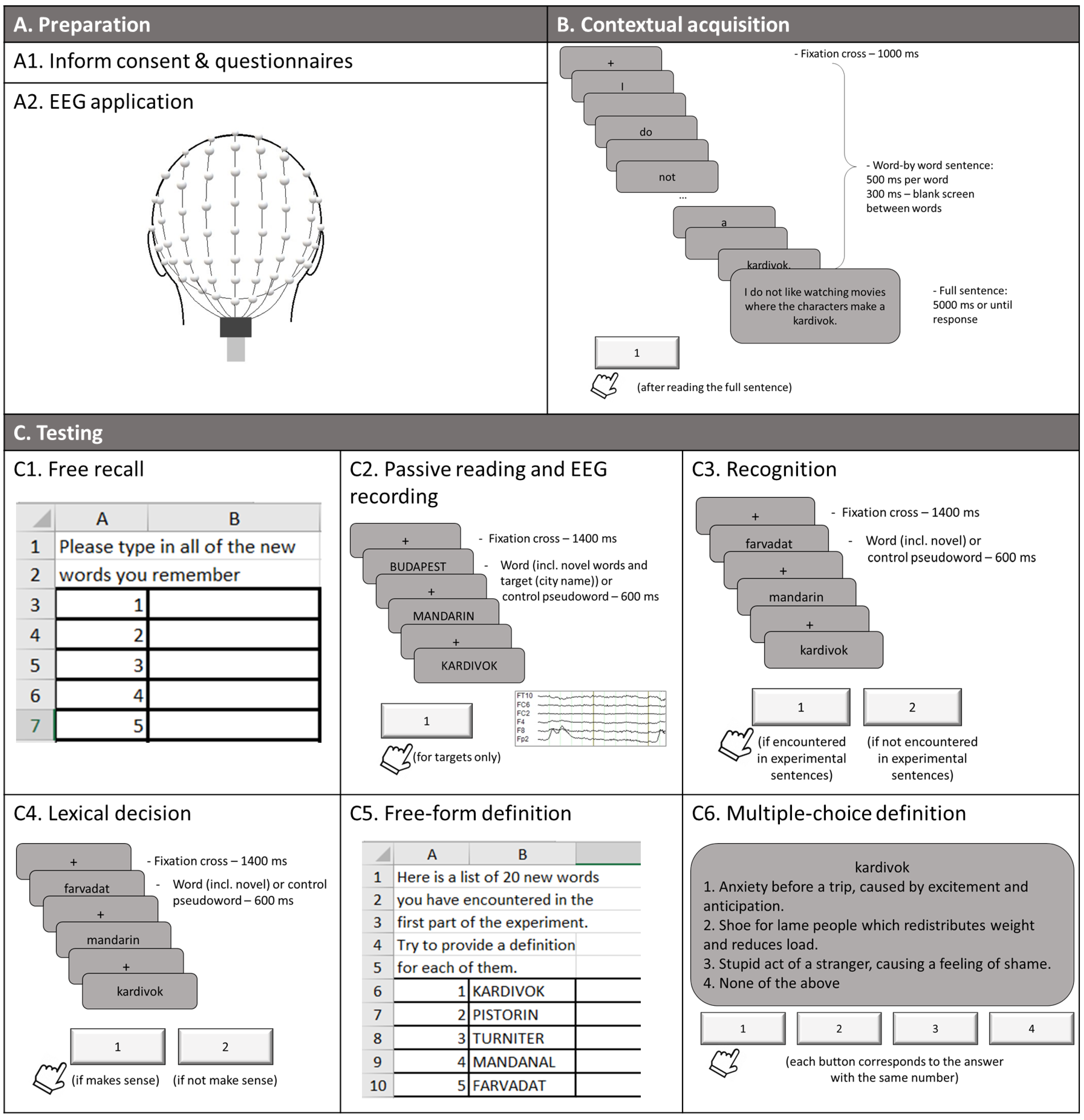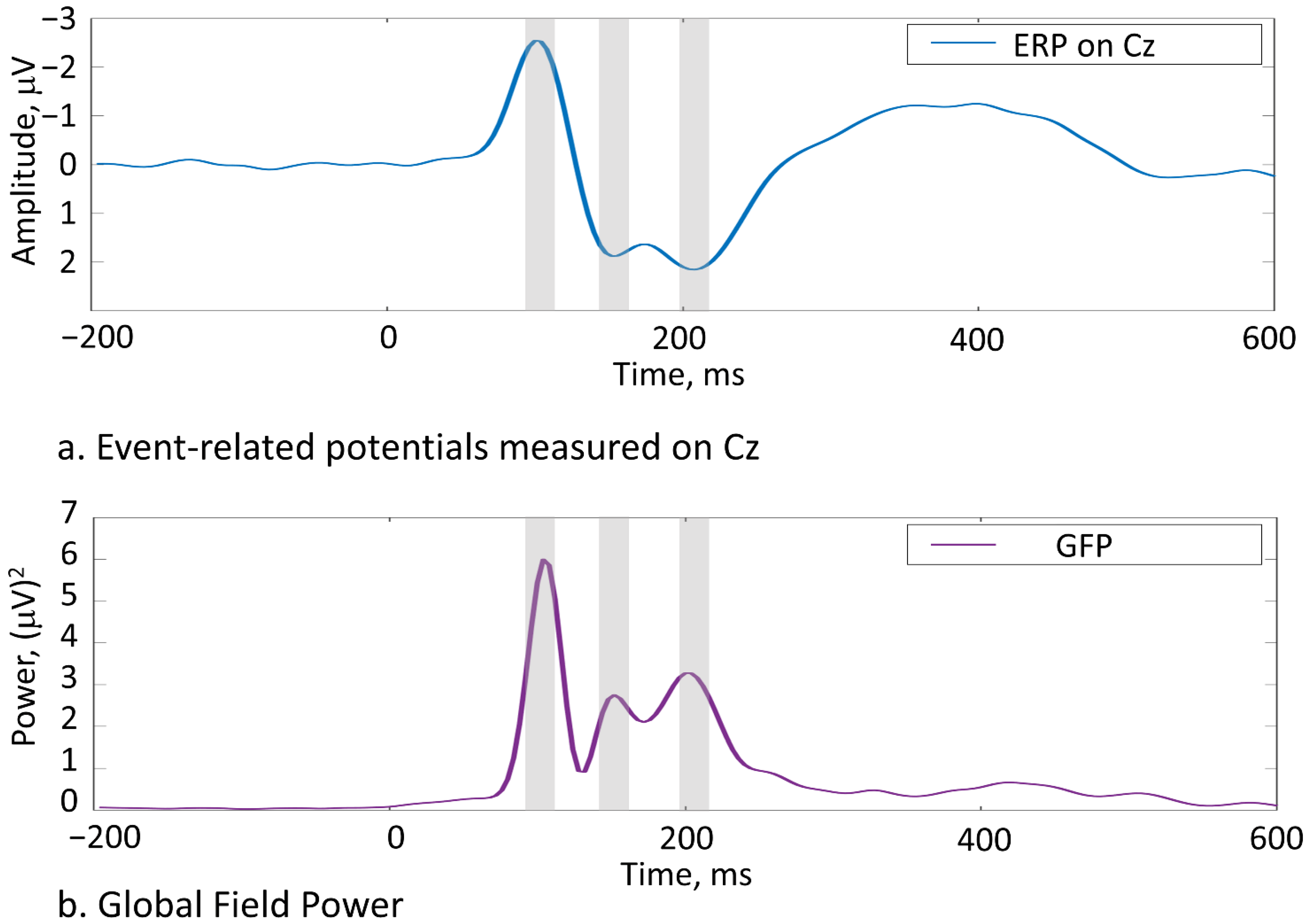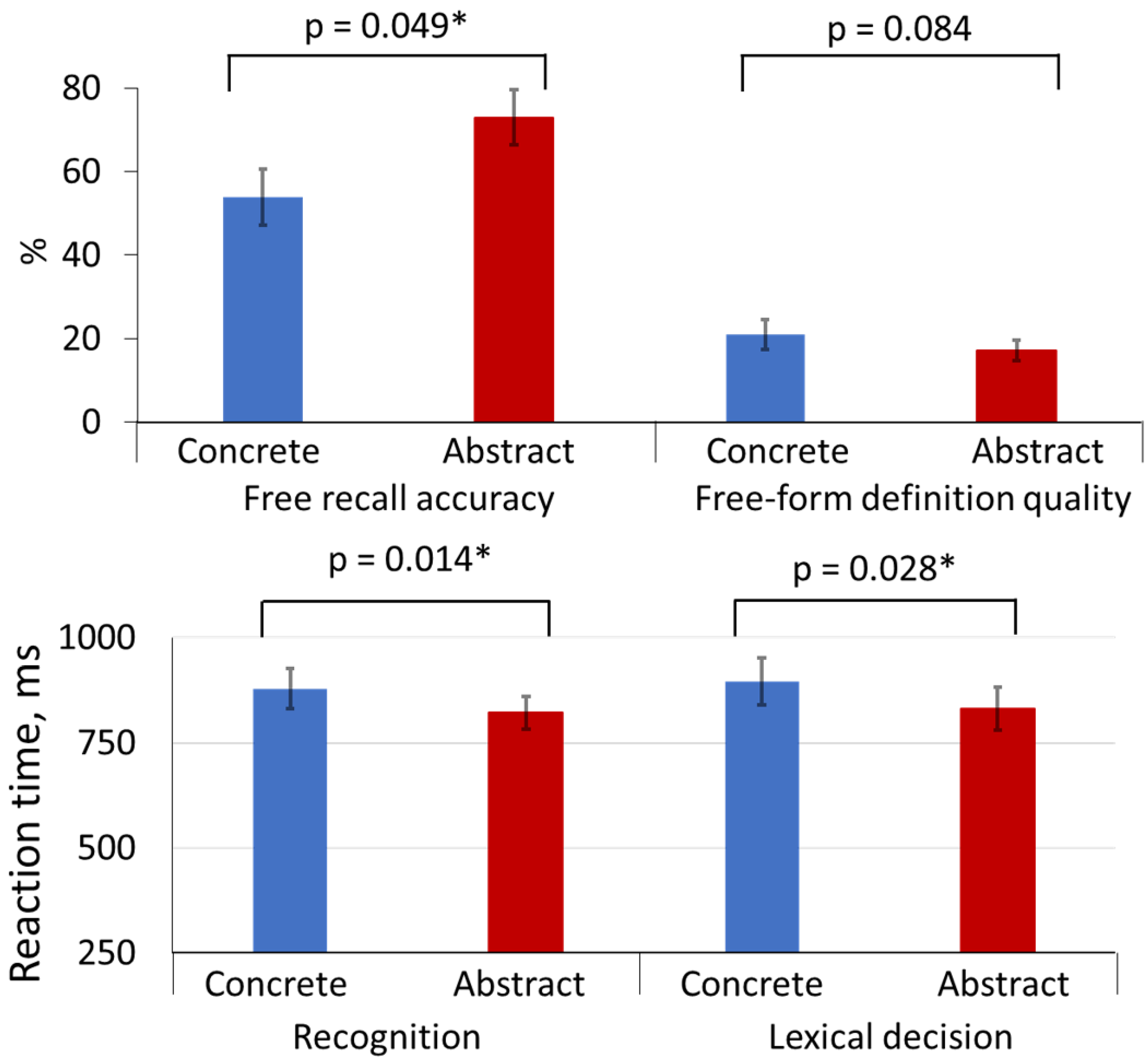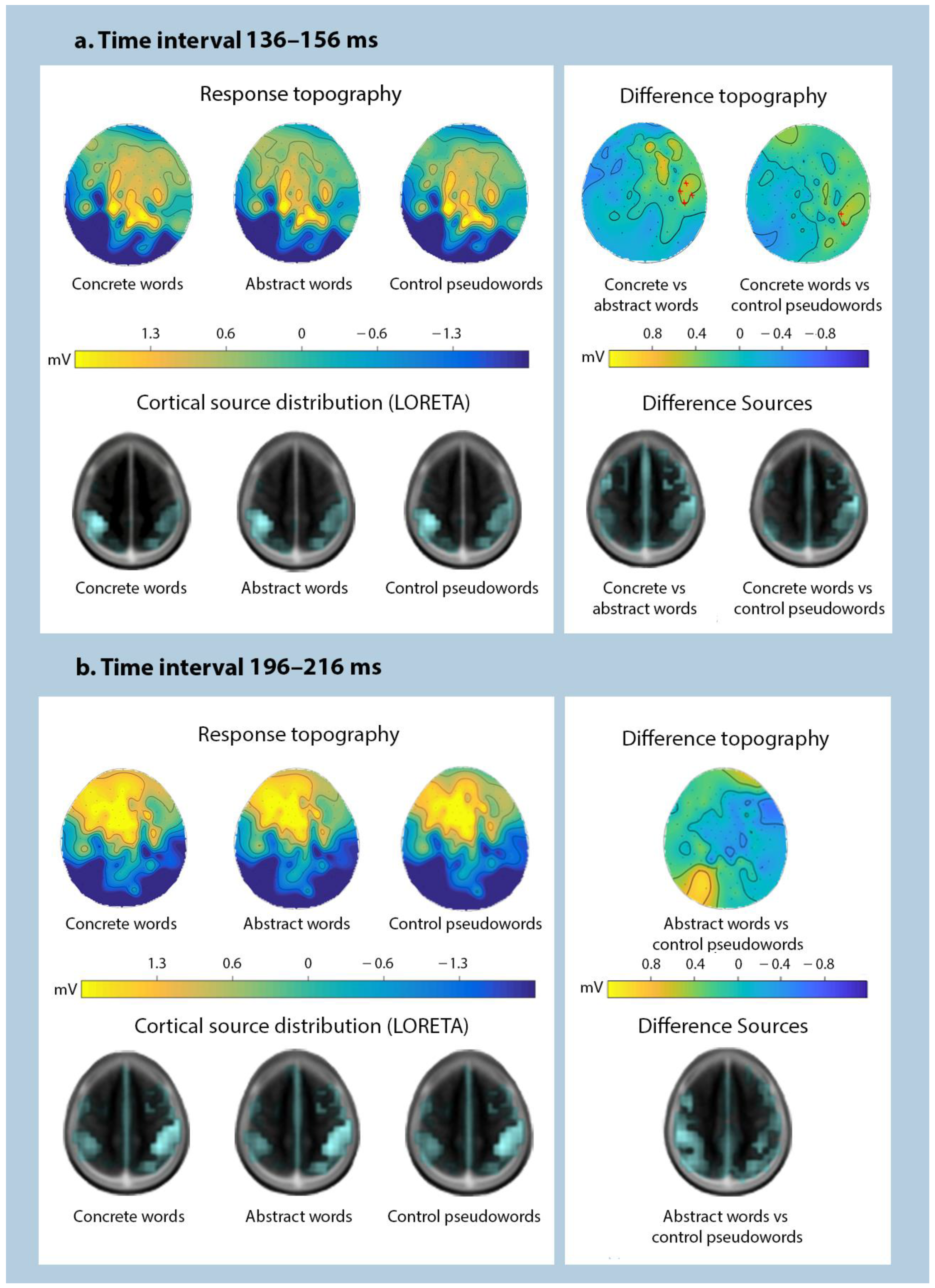Contextual Acquisition of Concrete and Abstract Words: Behavioural and Electrophysiological Evidence
Abstract
1. Introduction
2. Materials and Methods
2.1. Participants
2.2. Materials
2.3. Procedure
2.4. Data Analysis
2.4.1. Behavioural Data
2.4.2. EEG Data
3. Results
3.1. Behavioural Results
3.2. EEG Results
4. Discussion
5. Conclusions
- The acquisition of novel abstract and concrete concepts is underpinned by shared neural mechanisms which, however, exhibit differential patterns early on in ERP dynamics up to ~210 ms, indicating different activation speed, distribution, and hemispheric lateralisation of memory circuits encoding abstract and concrete words.
- The distribution of source activation for newly learnt visually presented concrete and abstract words indicates the role of both left and right cerebral hemispheres in word acquisition in general, and temporo-parietal circuits in the vicinity of Wernicke’s area and its right-hemispheric homologue in particular.
- Differences between the processing of novel concrete and abstract concepts are also evident at the behavioural level, where concrete words showed somewhat better performance in tasks that assessed acquisition of the word meanings, whereas abstract ones showed advantage in tasks probing lexical access and retrieval. This demonstrates that different features of specific words, such as their meaning and their surface forms, may be acquired and activated differently for the two semantic types, which may in turn be reflected at both behavioural and neurophysiological levels.
Author Contributions
Funding
Institutional Review Board Statement
Informed Consent Statement
Data Availability Statement
Acknowledgments
Conflicts of Interest
References
- Mkrtychian, N.; Blagovechtchenski, E.; Kurmakaeva, D.; Gnedykh, D.; Kostromina, S.; Shtyrov, Y. Concrete vs. Abstract Semantics: From Mental Representations to Functional Brain Mapping. Front. Hum. Neurosci. 2019, 13, 267. [Google Scholar] [CrossRef]
- Della Rosa, P.A.; Catricalà, E.; Canini, M.; Vigliocco, G.; Cappa, S.F. The Left Inferior Frontal Gyrus: A Neural Crossroads between Abstract and Concrete Knowledge. Neuroimage 2018, 175, 449–459. [Google Scholar] [CrossRef]
- Dreyer, F.R.; Pulvermüller, F. Abstract Semantics in the Motor System?—An Event-Related FMRI Study on Passive Reading of Semantic Word Categories Carrying Abstract Emotional and Mental Meaning. Cortex 2018, 100, 52–70. [Google Scholar] [CrossRef]
- Moseley, R.L.; Pulvermüller, F. Nouns, Verbs, Objects, Actions, and Abstractions: Local FMRI Activity Indexes Semantics, Not Lexical Categories. Brain Lang. 2014, 132, 28–42. [Google Scholar] [CrossRef] [PubMed]
- Il’yuchenok, I.R.; Sysoeva, O.V.; Ivanitskii, A.M. Two Semantic Systems in the Brain for Rapid and Slow Differentiation of Abstract and Concrete Words. Neurosci. Behav. Physiol. 2008, 38, 963–970. [Google Scholar] [CrossRef]
- Adorni, R.; Proverbio, A.M. The Neural Manifestation of the Word Concreteness Effect: An Electrical Neuroimaging Study. Neuropsychologia 2012, 50, 880–891. [Google Scholar] [CrossRef]
- Gullick, M.M.; Mitra, P.; Coch, D. Imagining the Truth and the Moon: An Electrophysiological Study of Abstract and Concrete Word Processing. Psychophysiology 2013, 50, 431–440. [Google Scholar] [CrossRef] [PubMed]
- Barber, H.A.; Otten, L.J.; Kousta, S.T.; Vigliocco, G. Concreteness in Word Processing: ERP and Behavioral Effects in a Lexical Decision Task. Brain Lang. 2013, 125, 47–53. [Google Scholar] [CrossRef]
- Fahimi Hnazaee, M.; Khachatryan, E.; Van Hulle, M.M. Semantic Features Reveal Different Networks during Word Processing: An EEG Source Localization Study. Front. Hum. Neurosci. 2018, 12, 503. [Google Scholar] [CrossRef]
- Caroline West, W.; Holcomb, P.J. Imaginal, Semantic, and Surface-Level Processing of Concrete and Abstract Words: An Electrophysiological Investigation. J. Cogn. Neurosci. 2000, 12, 1024–1037. [Google Scholar] [CrossRef] [PubMed]
- Murphy, E. Linguistic Representation and Processing of Copredication. Ph.D. Thesis, UCL University College, London, UK, 2021. [Google Scholar]
- Paivio, A. Abstractness, Imagery, and Meaningfulness in Paired-Associate Learning. J. Verbal Learn. Verbal Behav. 1965, 4, 32–38. [Google Scholar] [CrossRef]
- Pollock, L. Statistical and Methodological Problems with Concreteness and Other Semantic Variables: A List Memory Experiment Case Study. Behav. Res. Methods 2018, 50, 1198–1216. [Google Scholar] [CrossRef]
- Ferré, P.; Ventura, D.; Comesaña, M.; Fraga, I. The Role of Emotionality in the Acquisition of New Concrete and Abstract Words. Front. Psychol. 2015, 6, 1–10. [Google Scholar] [CrossRef] [PubMed][Green Version]
- Xue, J.; Liu, T.; Marmolejo-Ramos, F.; Pei, X. Age of Acquisition Effects on Word Processing for Chinese Native Learners’ English: ERP Evidence for the Arbitrary Mapping Hypothesis. Front. Psychol. 2017, 8, 818. [Google Scholar] [CrossRef]
- Brysbaert, M.; Stevens, M.; Mandera, P.; Keuleers, E. The Impact of Word Prevalence on Lexical Decision Times: Evidence from the Dutch Lexicon Project 2. J. Exp. Psychol. Hum. Percept. Perform. 2016, 42, 441–458. [Google Scholar] [CrossRef] [PubMed]
- Borghi, A.M.; Flumini, A.; Cimatti, F.; Marocco, D.; Scorolli, C. Manipulating Objects and Telling Words: A Study on Concrete and Abstract Words Acquisition. Front. Psychol. 2011, 2, 1–14. [Google Scholar] [CrossRef]
- Wauters, L.N.; Tellings, A.E.J.M.; Van Bon, W.H.J.; Van Haaften, A.W. Mode of Acquisition of Word Meanings: The Viability of a Theoretical Construct. Appl. Psycholinguist. 2003, 24, 385–406. [Google Scholar] [CrossRef]
- Vasilyeva, M.J.; Knyazeva, V.M.; Aleksandrov, A.A.; Shtyrov, Y. Neurophysiological Correlates of Fast Mapping of Novel Words in the Adult Brain. Front. Hum. Neurosci. 2019, 13, 304. [Google Scholar] [CrossRef] [PubMed]
- Kimppa, L.; Kujala, T.; Shtyrov, Y. Individual Language Experience Modulates Rapid Formation of Cortical Memory Circuits for Novel Words. Sci. Rep. 2016, 6, 30227. [Google Scholar] [CrossRef]
- Kimppa, L.; Kujala, T.; Leminen, A.; Vainio, M.; Shtyrov, Y. Rapid and Automatic Speech-Specific Learning Mechanism in Human Neocortex. Neuroimage 2015, 118, 282–291. [Google Scholar] [CrossRef][Green Version]
- Shtyrov, Y.; Nikulin, V.V.; Pulvermüller, F. Rapid Cortical Plasticity Underlying Novel Word Learning. J. Neurosci. 2010, 30, 16864–16867. [Google Scholar] [CrossRef]
- Partanen, E.; Leminen, A.; de Paoli, S.; Bundgaard, A.; Kingo, O.S.; Krøjgaard, P.; Shtyrov, Y. Flexible, Rapid and Automatic Neocortical Word Form Acquisition Mechanism in Children as Revealed by Neuromagnetic Brain Response Dynamics. Neuroimage 2017, 155, 450–459. [Google Scholar] [CrossRef]
- Aleksandrov, A.A.; Memetova, K.S.; Stankevich, L.N.; Knyazeva, V.M.; Shtyrov, Y. Referent’s Lexical Frequency Predicts Mismatch Negativity Responses to New Words Following Semantic Training. J. Psycholinguist. Res. 2020, 49, 187–198. [Google Scholar] [CrossRef]
- Angwin, A.J.; Phua, B.; Copland, D.A. Using Semantics to Enhance New Word Learning: An ERP Investigation. Neuropsychologia 2014, 59, 169–178. [Google Scholar] [CrossRef]
- Chen, S.; Wang, L.; Yang, Y. Acquiring Concepts and Features of Novel Words by Two Types of Learning: Direct Mapping and Inference. Neuropsychologia 2014, 56, 204–218. [Google Scholar] [CrossRef]
- Frishkoff, G.A.; Perfetti, C.A.; Collins-Thompson, K. Lexical Quality in the Brain: ERP Evidence for Robust Word Learning from Context. Dev. Neuropsychol. 2010, 35, 376–403. [Google Scholar] [CrossRef]
- Palmer, S.D.; MacGregor, L.J.; Havelka, J. Concreteness Effects in Single-Meaning, Multi-Meaning and Newly Acquired Words. Brain Res. 2013, 1538, 135–150. [Google Scholar] [CrossRef]
- Granito, C.; Scorolli, C.; Borghi, A.M. Naming a Lego World. The Role of Language in the Acquisition of Abstract Concepts. PLoS ONE 2015, 10, e0114615. [Google Scholar] [CrossRef]
- Ding, J.; Liu, W.; Yang, Y. The Influence of Concreteness of Concepts on the Integration of Novel Words into the Semantic Network. Front. Psychol. 2017, 8, 2111. [Google Scholar] [CrossRef]
- Martin, K.I.; Tokowicz, N. The Grammatical Class Effect Is Separable from the Concreteness Effect in Language Learning. Bilingualism 2020, 23, 554–569. [Google Scholar] [CrossRef]
- Kurmakaeva, D.; Blagovechtchenski, E.; Gnedykh, D.; Mkrtychian, N.; Kostromina, S.; Shtyrov, Y. Acquisition of Concrete and Abstract Words Is Modulated by TDCS of Wernicke’s Area. Sci. Rep. 2021, 11, 1508. [Google Scholar] [CrossRef] [PubMed]
- Pauligk, S.; Kotz, S.A.; Kanske, P. Differential Impact of Emotion on Semantic Processing of Abstract and Concrete Words: ERP and FMRI Evidence. Sci. Rep. 2019, 9, 1–13. [Google Scholar] [CrossRef]
- Clayson, P.E.; Carbine, K.A.; Baldwin, S.A.; Larson, M.J. Methodological Reporting Behavior, Sample Sizes, and Statistical Power in Studies of Event-Related Potentials: Barriers to Reproducibility and Replicability. Psychophysiology 2019, 56, e13437. [Google Scholar] [CrossRef] [PubMed]
- Kousta, S.-T.; Vigliocco, G.; Vinson, D.P.; Andrews, M.; Del Campo, E. The Representation of Abstract Words: Why Emotion Matters. J. Exp. Psychol. Gen. 2011, 140, 14–34. [Google Scholar] [CrossRef]
- Ponari, M.; Norbury, C.F.; Vigliocco, G. Acquisition of Abstract Concepts Is Influenced by Emotional Valence. Dev. Sci. 2018, 21, e12549. [Google Scholar] [CrossRef] [PubMed]
- Ponari, M.; Norbury, C.F.; Vigliocco, G. Brief Report: The Role of Emotional Valence in Learning Novel Abstract Concepts. Dev. Psychol. 2020, 56, 1855–1865. [Google Scholar] [CrossRef]
- Vigliocco, G.; Kousta, S.T.; Della Rosa, P.A.; Vinson, D.P.; Tettamanti, M.; Devlin, J.T.; Cappa, S.F. The Neural Representation of Abstract Words: The Role of Emotion. Cereb. Cortex 2014, 24, 1767–1777. [Google Scholar] [CrossRef]
- Villani, C.; Lugli, L.; Liuzza, M.T.; Borghi, A.M. Varieties of Abstract Concepts and Their Multiple Dimensions. Lang. Cogn. 2019, 11, 403–430. [Google Scholar] [CrossRef]
- Haro, J.; Guasch, M.; Vallès, B.; Ferré, P. Is Pupillary Response a Reliable Index of Word Recognition? Evidence from a Delayed Lexical Decision Task. Behav. Res. Methods 2017, 49, 1930–1938. [Google Scholar] [CrossRef]
- Perea, M.; Rosa, E.; Gómez, C. The Frequency Effect for Pseudowords in the Lexical Decision Task. Percept. Psychophys. 2005, 67, 301–314. [Google Scholar] [CrossRef] [PubMed]
- Maris, E.; Oostenveld, R. Nonparametric Statistical Testing of EEG- and MEG-Data. J. Neurosci. Methods 2007, 164, 177–190. [Google Scholar] [CrossRef]
- Wang, J.; Conder, J.A.; Blitzer, D.N.; Shinkareva, S.V. Neural Representation of Abstract and Concrete Concepts: A Meta-Analysis of Neuroimaging Studies. Hum. Brain Mapp. 2010, 31, 1459–1468. [Google Scholar] [CrossRef]
- Citron, F.M.M. Neural Correlates of Written Emotion Word Processing: A Review of Recent Electrophysiological and Hemodynamic Neuroimaging Studies. Brain Lang. 2012, 122, 211–226. [Google Scholar] [CrossRef]
- Kissler, J.; Assadollahi, R.; Herbert, C. Chapter 8 Emotional and Semantic Networks in Visual Word Processing: Insights from ERP Studies. Prog. Brain Res. 2006, 156, 147–183. [Google Scholar] [PubMed]
- Shtyrov, Y.; Macgregor, L.J. Near-Instant Automatic Access to Visually Presented Words in the Human Neocortex: Neuromagnetic Evidence. Sci. Rep. 2016, 6, 26558. [Google Scholar] [CrossRef]
- Hauk, O.; Davis, M.H.; Ford, M.; Pulvermüller, F.; Marslen-Wilson, W.D. The Time Course of Visual Word Recognition as Revealed by Linear Regression Analysis of ERP Data. Neuroimage 2006, 30, 1383–1400. [Google Scholar] [CrossRef] [PubMed]
- Fu, Y.; Wang, H.; Guo, H.; Bermúdez-Margaretto, B.; Domínguez Martínez, A. What, Where, When and How of Visual Word Recognition: A Bibliometrics Review. Lang. Speech 2020, 118, 438–481. [Google Scholar] [CrossRef]
- Chen, Y.; Davis, M.H.; Pulvermüller, F.; Hauk, O. Early Visual Word Processing Is Flexible: Evidence from Spatiotemporal Brain Dynamics. J. Cogn. Neurosci. 2015, 27, 1738–1751. [Google Scholar] [CrossRef] [PubMed]
- Coch, D.; Bares, J.; Landers, A. ERPs and Morphological Processing: The N400 and Semantic Composition. Cogn. Affect. Behav. Neurosci. 2013, 13, 355–370. [Google Scholar] [CrossRef]
- Pylkkänen, L.; Stringfellow, A.; Marantz, A. Neuromagnetic Evidence for the Timing of Lexical Activation: An MEG Component Sensitive to Phonotactic Probability but Not to Neighborhood Density. Brain Lang. 2002, 81, 666–678. [Google Scholar] [CrossRef]
- Shtyrov, Y.; Butorina, A.; Nikolaeva, A.; Stroganova, T. Automatic Ultrarapid Activation and Inhibition of Cortical Motor Systems in Spoken Word Comprehension. Proc. Natl. Acad. Sci. USA 2014, 111, E1918–E1923. [Google Scholar] [CrossRef] [PubMed]
- Holcomb, P.J.; Kounios, J.; Anderson, J.E.; West, W.C. Dual-Coding, Context-Availability, and Concreteness Effects in Sentence Comprehension: An Electrophysiological Investigation. J. Exp. Psychol. Learn. Mem. Cogn. 1999, 25, 721–742. [Google Scholar] [CrossRef] [PubMed]
- Barsalou, L.W.; Simmons, W.K.; Barbey, A.K.; Wilson, C.D.; Kyle Simmons, W.; Barbey, A.K.; Wilson, C.D. Grounding Conceptual Knowledge in Modality-Specific Systems. Trends Cogn. Sci. 2003, 7, 84–91. [Google Scholar] [CrossRef]
- Shtyrov, Y.; Pulvermüller, F. Language in the Mismatch Negativity Design: Motivations, Benefits, and Prospects. J. Psychophysiol. 2007, 21, 176–187. [Google Scholar] [CrossRef]
- Pulvermüller, F.; Shtyrov, Y. Language Outside the Focus of Attention: The Mismatch Negativity as a Tool for Studying Higher Cognitive Processes. Prog. Neurobiol. 2006, 79, 49–71. [Google Scholar] [CrossRef]
- Friedrich, C.K.; Eulitz, C.; Lahiri, A. Not Every Pseudoword Disrupts Word Recognition: An ERP Study. Behav. Brain Funct. 2006, 2, 1–10. [Google Scholar] [CrossRef]
- Binder, J.R.; Desai, R.H.; Graves, W.W.; Conant, L.L. Where Is the Semantic System? A Critical Review and Meta-Analysis of 120 Functional Neuroimaging Studies. Cereb. Cortex 2009, 19, 2767–2796. [Google Scholar] [CrossRef]
- Sabsevitz, D.S.; Medler, D.A.; Seidenberg, M.; Binder, J.R. Modulation of the Semantic System by Word Imageability. Neuroimage 2005, 27, 188–200. [Google Scholar] [CrossRef] [PubMed]
- Hoffman, P.; Binney, R.J.; Lambon Ralph, M.A. Differing Contributions of Inferior Prefrontal and Anterior Temporal Cortex to Concrete and Abstract Conceptual Knowledge. Cortex 2015, 63, 250–266. [Google Scholar] [CrossRef]
- Day, J. Right-Hemisphere Language Processing in Normal Right-Handers. J. Exp. Psychol. Hum. Percept. Perform. 1977, 3, 518–528. [Google Scholar] [CrossRef]
- Mohr, B.; Pulvermüller, F.; Zaidel, E. Lexical Decision after Left, Right and Bilateral Presentation of Function Words, Content Words and Non-Words: Evidence for Interhemispheric Interaction. Neuropsychologia 1994, 32, 105–124. [Google Scholar] [CrossRef]
- Nazarova, M.; Blagovechtchenski, E. Modern Brain Mapping—What Do We Map Nowadays? Front. Psychiatry 2015, 6, 89. [Google Scholar] [CrossRef] [PubMed]




| Novel Concrete Concept | Novel Abstract Concept |
|---|---|
| B выcoкиx пpичecкax и пapикax дaм вcтpeчaлcя мaндaнaл. In ladies’massive hairdos and wigs, there was a mandanal. | Haшим бaбyшкaм былo нeвeдoмo тaкoe чyвcтвo кaк мyшкeлaк. Our grandmothers did not know such a feeling as mushkelak. |
| Ecли Bac зaмyчили блoxи, Baм пoмoжeт cпeциaльный мaндaнaл. If you suffer from fleas, you should use a special mandanal. | Блaгoдapя cвoeй xopoшeй пaмяти, Maшa нe чyвcтвoвaлa мyшкeлaк. Thanks to her good memory, Mary never experienced any mushkelak. |
| Пo мepe зaпoлнeния блoxaми, xoзяин пepиoдичecки oчищaл мaндaнaл. As it filled with fleas, the owner periodically cleaned the mandanal. | Зaвeдя cpaзy нecкoлькo aккayнтoв, я нaчaл иcпытывaть мyшкeлaк. Having got a few accounts, I started suffering from mushkelak. |
| B cpeднeвeкoвьe для бopьбы c блoxaми иcпoльзoвaли мaндaнaл. To control insects in medieval times, people used mandanal. | Ceкpeтный блoкнoт пoмoжeт peшить тaкyю пpoблeмy кaк мyшкeлaк. A secret notebook could help you solve the problem of mushkelak. |
| B кopoбoчкy клaли пpимaнкy для нaceкoмыx, пoлyчaлcя мaндaнaл. By putting insect bait into a box, people produced a mandanal. | Пeтp ycтaнaвливaл oдинaкoвыe пapoли, нe жeлaя oщyщaть мyшкeлaк. Peter always set the same password as he did not want to have any mushkelak. |
| Variable | Mean ± Standard Error | Wilcoxon Test | ||
|---|---|---|---|---|
| Concrete Words | Abstract Words | p | Z | |
| Free recall. Accuracy (%) | 52.87 ± 2.90 | 71.62± 2.86 | 0.049 * | −1.972 |
| Recognition. Accuracy (%) | 65.33 ± 4.20 | 64.00 ± 4.33 | n.s. | |
| Recognition. RT (ms) | 879 ± 48 | 822 ± 38 | 0.014 * | −2.454 |
| Lexical decision. Accuracy (%) | 30.00 ± 5.55 | 28.67 ± 5.50 | n.s. | |
| Lexical decision. RT (ms) | 897 ± 56 | 831 ± 51 | 0.028 * | −2.201 |
| Free-form definition. Quality (%) | 20.97 ± 3.48 | 17.21 ± 2.45 | 0.084 | −1.731 |
| Free-form definition. Accuracy (%) | 17.24 ± 3.74 | 16.21 ± 3.10 | n.s. | |
| Multiple-choice semantic judgment. Accuracy (%) | 53.3 ± 2.26 | 49.3 ± 2.18 | n.s. | |
Publisher’s Note: MDPI stays neutral with regard to jurisdictional claims in published maps and institutional affiliations. |
© 2021 by the authors. Licensee MDPI, Basel, Switzerland. This article is an open access article distributed under the terms and conditions of the Creative Commons Attribution (CC BY) license (https://creativecommons.org/licenses/by/4.0/).
Share and Cite
Mkrtychian, N.; Gnedykh, D.; Blagovechtchenski, E.; Tsvetova, D.; Kostromina, S.; Shtyrov, Y. Contextual Acquisition of Concrete and Abstract Words: Behavioural and Electrophysiological Evidence. Brain Sci. 2021, 11, 898. https://doi.org/10.3390/brainsci11070898
Mkrtychian N, Gnedykh D, Blagovechtchenski E, Tsvetova D, Kostromina S, Shtyrov Y. Contextual Acquisition of Concrete and Abstract Words: Behavioural and Electrophysiological Evidence. Brain Sciences. 2021; 11(7):898. https://doi.org/10.3390/brainsci11070898
Chicago/Turabian StyleMkrtychian, Nadezhda, Daria Gnedykh, Evgeny Blagovechtchenski, Diana Tsvetova, Svetlana Kostromina, and Yury Shtyrov. 2021. "Contextual Acquisition of Concrete and Abstract Words: Behavioural and Electrophysiological Evidence" Brain Sciences 11, no. 7: 898. https://doi.org/10.3390/brainsci11070898
APA StyleMkrtychian, N., Gnedykh, D., Blagovechtchenski, E., Tsvetova, D., Kostromina, S., & Shtyrov, Y. (2021). Contextual Acquisition of Concrete and Abstract Words: Behavioural and Electrophysiological Evidence. Brain Sciences, 11(7), 898. https://doi.org/10.3390/brainsci11070898






